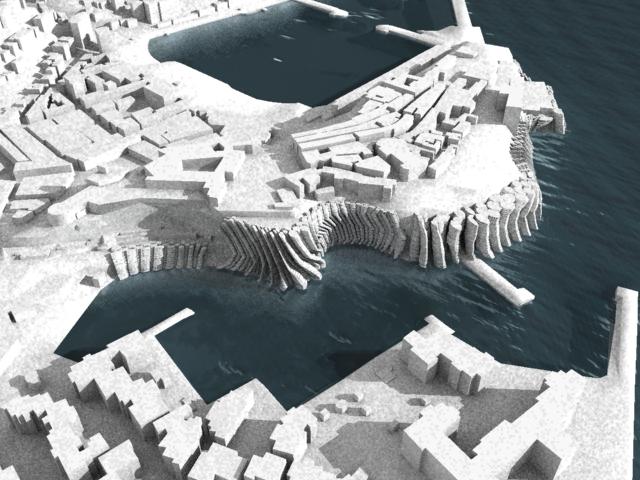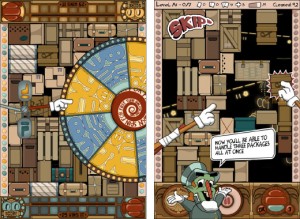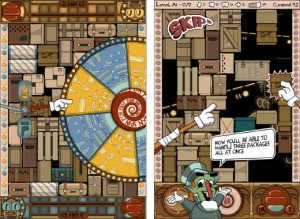27 June 2013
Guest Piece: Pursuing the Indie Dream
Nicholas Lister is an independent game developer based in London, UK. His first mobile game, Imp Paired, which was created with Corona SDK, is due for release in Summer 2013.
Nicholas came to game development in 2010 after turning away from the architectural profession and finding himself in search of a new career. Imp Paired is a bold and humorous memory game, but it also carries a depth of meaning that Nicholas believes to be a residual effect of his architectural education, one for which making games has provided a new outlet.
 My name is Nicholas Lister and I am an independent game developer. I am currently running up to the launch of Imp Paired, a game for which I have been using Corona SDK and, in fact, the first fully fledged mobile game I have ever made. You see, my background isn’t in game development at all; when I decided to take it up, I was turning away from six years of training to become an architect.
My name is Nicholas Lister and I am an independent game developer. I am currently running up to the launch of Imp Paired, a game for which I have been using Corona SDK and, in fact, the first fully fledged mobile game I have ever made. You see, my background isn’t in game development at all; when I decided to take it up, I was turning away from six years of training to become an architect.
I had been tantalisingly close to qualifying. I had completed a degree, a masters level diploma, a year in professional practice and all I had left to do was complete one more year of practical experience and my final exams to become a certified architect. The trouble was, after six years I wasn’t so sure I wanted to be an architect. I certainly wasn’t sure I was all that keen on practicing architecture and I had definitely started to realise how ambivalent I was about the profession.
I came out of architecture school depressed and drifting, not quite sure what to do or where to turn. In search of a new direction and a new career path I tried my hand all kinds of things, from graphic design and web design through modelling and writing, but nothing really took hold.
It wasn’t until one day, when a friend started talking about videogames, that something clicked in the back of my brain. I realised I had some programming skills, I had designed interactive environments, I could make graphics, I had a computer, I was lucky to have inherited enough money to live on for a while and I realised that making videogames didn’t mean having a publisher or having to make something huge any more. I could make videogames.
At that time, the arrival of distribution platforms like Apple’s App Store had meant that it was feasible to make something small yourself, to get it out there in front of a lot of people and maybe even make some money out of it. Sure, the long game was bigger and more complicated, but that essential freedom to produce and to explore making games without the need for clients or bosses, and to do so professionally, was a seductive indie dream and I set about pursuing it.
I just decided that I was going to make a go of it and unlike anything else I had tried it stuck. I found a passion for it and found it fulfilling in a way that nothing else I had tried had been. It provided the opportunity to make things that were significant and meaningful, to explore a relatively nascent and incredibly vibrant medium. It was what I had been looking for.
I was terribly naive of course. Making a good videogame is massively more difficult than I had anticipated. When I started out, instead of making the games I wanted to make, I found myself wrestling with the tools I needed. In that respect discovering Corona SDK was a big help. It meant that a person like me, working alone, could just get on and make something without having to master low level APIs like OpenGL ES. Even with the help of Corona, though, the creative and technical process behind game development was much tougher than I had expected. In a way I think the naivety with which I threw myself in really helped. Without it I’m not sure I would have got to this stage.

Perhaps I should qualify some of what I have said above by pointing out that my architectural education was less about designing buildings than it was about creating building systems. Sometimes that meant parametric design, where I was writing some basic software that allowed the computer to determine the material form of a building, as in the image above. At other times it meant designing kinetic and interactive structures like the community center for a car park in Acton, West London (below). All those little pavilions are able to be manipulated in some way: changing lighting, extending awnings, changing seating rakes and so on. Whenever they are put in a certain state they remember what the state was and when (in relation to other pavilions being put into states) they were put in into it. The pavilions then try to put themselves in the correct states at the correct times so the whole thing becomes this giant, slightly chaotic, clock that ripples the interactions of users across the whole complex. It was the skills I picked up working on designs like this that I felt I could transfer over into making videogames.

In fact, when I got into it, I discovered that I was still at a very low level with the hard skills like programming and interactive system design that I thought I had under my belt. What I did have, however, was something I had never even considered, but which I now find to be amazingly useful, and that is an approach to game design that stems from the point of view of an architect.
What that means exactly is a little complicated to go into here, and I have written about various aspect of it elsewhere, but at its core I think there are two key things. The first stems from a definition of architecture to which I personally subscribe and which holds that architecture is building plus meaning. I think it is my experience designing within that framework that has put the pursuit of meaning at the heart of all my creative work. The second key thing is how I tend to do that in games, which is by trying to ask players meaningful questions and to give them a space, albeit a slightly loaded one, to examine those questions in a practical, playful, ludic way.
I have come a long way from where I was when I set out on this crazy journey to where I am now, but it has really been the things that I have carried with me all the way that have been the most important. Finding the right tools to let them emerge and to let me give them voice has been invaluable. They are what makes my work, including Imp Paired, distinct and perhaps more importantly they are really what connects my work back to me.
Watch for Imp Paired in the App Store this summer, and check out several screenshots below.




Stefan Nowak
Posted at 02:52h, 28 JuneInteresting article, Nicholas. I also started out studying Architecture (but that was 40 years ago!) so I can relate to your experience. However, at that time computers filled a room and it took a week to have your code put on to punch-cards and get back the printed results. Interactivity was a long way off so I ended up teaching before moving into IT – long story …
I’m also based in London so it would be good to get in touch.
Stefan
Nicholas Lister
Posted at 02:47h, 29 JuneThanks Stefan,
I guess 40 years ago were really the very early days of interactive design as we know it today, but also a time when some terrifically interesting ideas seem to have been about. There seems to have been a spirit of hope in information technology, particularly one infused with a sense of playfulness and public joy. There was the cybernetics research of people like Grey Walter and Gordon Pask, the hopeful, if flawed, system Nicholas Negroponte outlined in The Architecture Machine, and perhaps most significantly the architectural designs of people like the Archigram Group and Cedric Price. I guess it was a time when the computer as the universal machine we know it today was still a long way off, but the ideas that the spectre promised were electrifying the imaginations of incredibly talented people.
Sorry, I rambled on a bit there. I try to get out to various developer events in London and elsewhere around the country, so if you see me do come and say hi. It would be good to chat.
Rycott
Posted at 09:27h, 04 JulyEstimado Nicholas,
Soy de Chile y curiosamente también me ocurrió lo mismo. Estudié 4 años arquitectura, más un año diseño gráfico y llevo 16 años desarrollando multimedia, enamorado de hacer apps… soy un agradecido de las disciplinas de arte y matemáticas que te entrega arquitectura y creo que fue necesario pasar por ello para estar programando hoy en CoronaLabs, Pasé mucho tiempo con actionscript en flash.
Espero que esta plataforma continúe y siga fortaleciéndose para generar buenas apps. Echo de menos comandos para mapping, pero vamos paso a paso.
Desde Chile un gran abrazo y que bueno saber que no solo me pasó a mi esto de pasar de arquitectura a desarrollo de apps.
Óscar (Rycott) Salgado.
Chile.
Ian Masters
Posted at 09:56h, 04 JulyDon’t forget the Corona SDK London Meetup happening this Saturday:
http://www.meetup.com/Corona-SDK-London-Meetup/
Ian
Nicholas Lister
Posted at 06:32h, 05 JulyI saw this was on and would love to come down and hang out with you guys and girls. Unfortunately, though, I have other commitments during the day that I can’t get out of.
I will be at the Develop Conference in Brighton next Wednesday and Thursday, though.